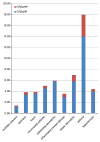Chronic rhinosinusitis in the setting of other chronic inflammatory diseases
- PMID: 20832903
- PMCID: PMC3387732
- DOI: 10.1016/j.amjoto.2010.07.013
Chronic rhinosinusitis in the setting of other chronic inflammatory diseases
Abstract
Objectives: The objectives of the study were to determine the prevalence of chronic rhinosinusitis (CRS) overall and its 2 phenotypic variants, CRS with and without polyposis (NP), in patients with chronic inflammatory comorbidities including autoimmune disorders, inflammatory bowel disease, and atopic dermatitis. These findings were compared with data in patients with asthma. Patients with hypertension were also used as a reference group to estimate the incidence of CRS in a group with regular medical follow-up.
Study design: A retrospective, cross-sectional query of a large tertiary care electronic medical record database was performed.
Results: Electronic medical record database prevalence of CRS in patients with hypertension was 4.4%. The prevalence of CRS was 18% in asthma (P < .0001), 7% in atopic dermatitis, 3.5% in inflammatory bowel disease, and ranged from 1.4% to 5.9% in autoimmune disorders. The frequency of CRS patients exhibiting the NP phenotype was similarly low in patients with autoimmune disease and hypertension, but was significantly greater in patients with asthma (P < .0001), inflammatory bowel disease (P = .033), and atopic dermatitis (P = .049),
Conclusions: These findings suggest similar prevalence of overall CRS in patients with autoimmune disease and inflammatory bowel disease, and background rates as estimated by observations in hypertension patients. Inflammatory bowel disease and atopic dermatitis patients with CRS exhibit some skewing toward the NP phenotype, as do asthmatics, where this association is well known.
Copyright © 2011 Elsevier Inc. All rights reserved.
Conflict of interest statement
Conflicts of interest: none. Financial support: none.
Figures
References
-
- Van Zele T, Claeys S, Gevaert P, et al. Differentiation of chronic sinus diseases by measurement of inflammatory mediators. Allergy. 2006;61:1280–9. - PubMed
-
- Bresciani M, Paradis L, Des Roches A, et al. Rhinosinusitis in severe asthma. J Allergy Clin Immunol. 2001;107:73–80. - PubMed
-
- Hamilos DL. Chronic rhinosinusitis patterns of illness. Clin Allergy Immunol. 2007;20:1–13. - PubMed
Publication types
MeSH terms
Grants and funding
LinkOut - more resources
Full Text Sources
Medical
Miscellaneous


